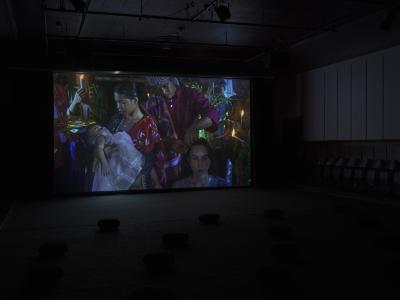Biraddali Dancing on the Horizon
Jul 13 — Aug 10, 2024
Description:
Biraddali Dancing on the Horizon (2024) was a new moving image commission and the first solo exhibition in Canada by Filipina-Australian artist Bhenji Ra.Biraddali Dancing on the Horizon (2024) documents a process of ancestral, intergenerational learning. Its starting point is a ritual journey taken by Ra with her teacher and collaborator Sitti Airia Sangkula Askalani-Obeso. A Tausug elder, Obeso is a cultural bearer of the pangalay, a pre-Islamic dance of the Tausug people of the Sulu Archipelago and the eastern coast Bajau of Sabah in the Philippines.
Falling into a dreamlike ancestral plane, Obeso and Ra develop and trouble the roles of student and teacher, mother and daughter. Whilst relaying the history of the pangalay, Ra and Obeso explore the cultures and structures of movement practices in the Sulu Archipelago and their relationship to precolonial understandings of gender and identity, in particular the bantot or bayot relating to a trans feminine person. A fabulation unfolds in which a celestial being that resembles a woman with wings and supernatural beauty, known across the Sulu as the Biraddali, reveals itself through dialogue and dreaming. Translated from Tausug or other Samal languages as “angel” or “skymaiden,” the Biraddali are believed to live in the sky and possess the power to change their form. As the imaginal passage unfolds, the dance of pangalay and the figure of the Biraddali become symbolically interrelated, with Ra interpreting the Biraddali as a trans, non-human figure and the originator of the dance.
Initially appearing documentarian in style, Biraddali Dancing on the Horizon unravels into its own mythology as the bond of mentorship becomes an offering that weaves bantot and Tausug genealogies together. The film foregrounds a pedagogy of decolonial choreography. It develops languages of movement that connect vocabularies of gender with past and present colonial realities in the Asia-Pacific region. This continues Ra’s ongoing work exploring methods of performance that decentre hegemonic Western dance conventions, and which engage critically with expressions of gender and sexual difference.
The thirty-minute film features a new musical score composed by Tati au Miel. Ra's installation in the Grand Luxe Hall was accompanied by three photographic textile works displayed on the first and second floors of Western Front.
Biraddali Dancing on the Horizon was co-commissioned by Auto Italia, London and presented with support from the Government of Canada.
Curated by Susan Gibb and Kiel Torres.
Documents:












Related People
- Susan Gibb (Curator)
- Kiel Torres (Curator)
Captions:
- Bhenji Ra on Biraddali Dancing on the Horizon (2024). 7 min. 37 sec. Filmed by Mike Southworth.
- Bhenji Ra: Biraddali Dancing on the Horizon, installation view, Jul 13 – Aug 10, 2024. Photo by Dennis Ha.
- Bhenji Ra: Biraddali Dancing on the Horizon, installation view, Jul 13 – Aug 10, 2024. Photo by Dennis Ha.
- Bhenji Ra: Biraddali Dancing on the Horizon, installation view, Jul 13 – Aug 10, 2024. Photo by Dennis Ha.
- Bhenji Ra: Biraddali Dancing on the Horizon, installation view, Jul 13 – Aug 10, 2024. Photo by Dennis Ha.
- Bhenji Ra: Biraddali Dancing on the Horizon, installation view, Jul 13 – Aug 10, 2024. Photo by Dennis Ha.
- Bhenji Ra: Biraddali Dancing on the Horizon, installation view, Jul 13 – Aug 10, 2024. Photo by Dennis Ha.
- Bhenji Ra: Biraddali Dancing on the Horizon, installation view, Jul 13 – Aug 10, 2024. Photo by Dennis Ha.
- Bhenji Ra: Biraddali Dancing on the Horizon, installation view, Jul 13 – Aug 10, 2024. Photo by Dennis Ha.
- Bhenji Ra, Buffalo Ancestor (2024), installation view, Jul 13 – Aug 10, 2024. Photo by Dennis Ha.
- Bhenji Ra: Biraddali Dancing on the Horizon, installation view, Jul 13 – Aug 10, 2024. Photo by Dennis Ha.
- Bhenji Ra, Crocodile Ancestor (2024), installation view, Jul 13 – Aug 10, 2024. Photo by Dennis Ha.
- Bhenji Ra, Pangalay Twin Ancestor (2024), installation view, Jul 13 – Aug 10, 2024. Photo by Dennis Ha.
